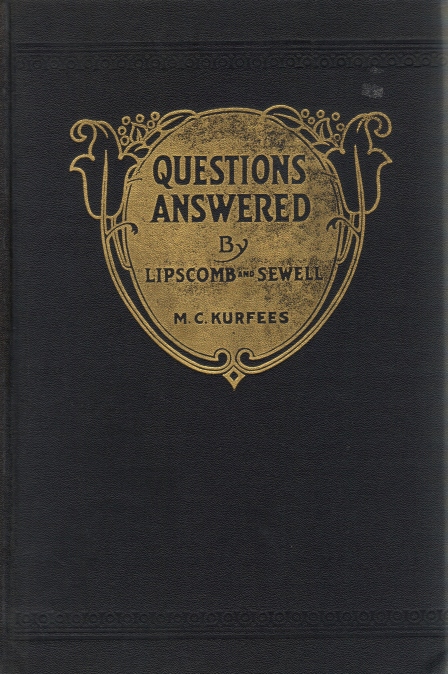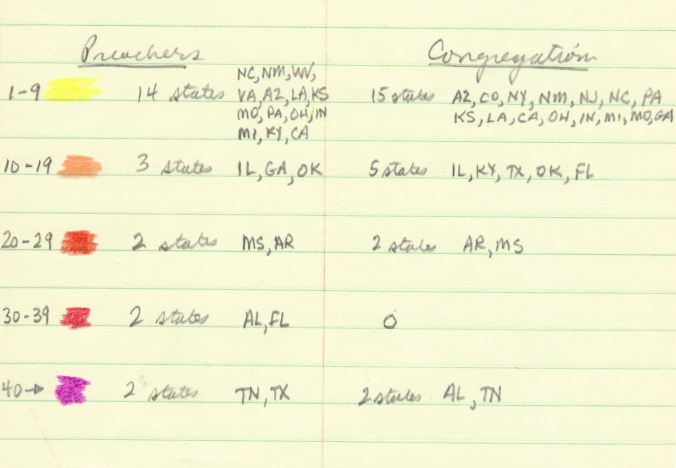Compiled by McGarvey Ice, 9 November 2017
I list entries under three headings: BOOKS and MONOGRAPHS are stand-alone publications authored by David Lipscomb, or contain his works as edited by others; ESSAYS or CHAPTERS are materials authored by Lipscomb and published during his lifetime. These are not stand-alone publications; finally, BIOGRAPHICAL and INTERPRETIVE list biographical sketches about Lipscomb (published during his life and after his death) and scholarly interpretive works about his life and thought. I list entries under each heading chronologically by date of first publication. I note subsequent editions and/or reprintings only at the entry of first publication. In a few cases I add additional notes. Additions, corrections, and comments are welcome at mac.ice@acu.edu. Click here to download the bibliography in PDF format.
BOOKS and MONOGRAPHS
Lipscomb, David. The Religious Sentiment, Its Social and Political Influence: An Address Before the Alumni Society of Franklin College, Tenn., delivered on the 4th of July, 1855. Nashville: Cameron & Fall, 1855. 36 p.
Lipscomb, David. Offerings to the Lord: A Tract. Nashville: Lipscomb & Sewell, 1878. 42 p.

David Lipscomb. Offerings to the Lord: A Tract. Nashville: Lipscomb & Sewell, 1878.
[Lipscomb, David] The Standard and the Hymn-Book, with An Exposition of Its Course Toward the Missionary Society. Nashville: A. M. Sewell, 1883. 32 p.

[David Lipscomb] The Standard and the Hymn-Book, with An Exposition of Its Course Toward the Missionary Society. Nashville: A. M. Sewell, 1883.
Lipscomb, D. Christian Unity. How Promoted, How Destroyed. Faith and Opinion. Nashville: Gospel Advocate Publishing Company, 1891. 64 p. Reprinted by McQuiddy Printing Company, Nashville, 1916. Reprinted under a short title, On Christian Unity, by Doulos Christou Press, Indianapolis, 2006.

D. Lipscomb. Christian Unity. How Promoted, How Destroyed. Faith and Opinion. Nashville: McQuiddy Printing Company, Nashville, 1916.
Lipscomb, D. Civil Government. Its Origin, Mission, and Destiny, and the Christian’s Relation To It. Nashville: Gospel Advocate Publishing Company, 1889. 158 p. Reprinted by McQuiddy Printing Company, Nashville, 1913; Gospel Advocate Company, 1957. Reprinted by Vance Publications, Pensacola, 2006. This material appeared earlier in Christian Quarterly Review, issues of October 1888, January 1889 and July 1889.

D. Lipscomb. Civil Government. Its Origin, Mission, and Destiny, and the Christian’s Relation To It. Nashville: Gospel Advocate Publishing Company, 1889.
Lipscomb, D. Life and Sermons of Jesse L. Sewell. An Account of His Life, Labors and Character. Nashville: Gospel Advocate Publishing Company, 1891. 318 p. Second and third ‘editions’, actually printings, in 1891 by Gospel Advocate Publishing Company. Fourth ‘edition’ by Gospel Advocate Company, Nashville, 1954.
Lipscomb, David. Notes on the International S. S. Lessons for 1895. Nashville: Gospel Advocate Publishing Company, [1895]. 279, 1, 34 p.

David Lipscomb. Notes on the International S. S. Lessons for 1895. Nashville: Gospel Advocate Publishing Company, [1895]
Lipscomb, D. A Commentary on the Acts of the Apostles, with Questions Suited for the Use of Families and Schools. Nashville: Gospel Advocate Publishing Company, 1896. 249, 5 p. Printed at least four times, one perhaps as late as 1939.
[Lipscomb, David] Instruments of Music in the Service of God: An Examination of the Subject from the Teaching of Both the Old and the New Testaments. Nashville: McQuiddy Printing Company, [1903]. This tract first appeared in a three-part series of articles in Gospel Advocate in October 1901.

[David Lipscomb] Instruments of Music in the Service of God: An Examination of the Subject from the Teaching of Both the Old and the New Testaments. Nashville: McQuiddy Printing Company, [1903].
Shepherd, J. W. Queries and Answers by David Lipscomb, Editor of the Gospel Advocate. Nashville: McQuiddy Printing Company, 1910. 458 p. Second and third editions in 1910 and 1911 respectively, both by McQuiddy Printing Company. Fourth and fifth editions by F. L. Rowe, Cincinnati, 1918 and 1942 respectively. Also a Fifth edition by Gospel Advocate Company, Nashville, 1963. All subsequent ‘editions’ after the first are actually printings.
Shepherd, J. W. Salvation from Sin by David Lipscomb, Editor of the Gospel Advocate. Nashville: McQuiddy Printing Company, 1913. x, 440 p. ‘Second edition’, actually a printing, by Gospel Advocate Company, Nashville, 1950. Reprinted by Faith and Facts, Indianapolis, ca. 1995.
Kurfees, M. C., ed. Queries and Answers by Lipscomb and Sewell being A Compilation of Queries with Answers by D. Lipscomb and E. G. Sewell, covering a period of forty years of their joint editorial labors on the Gospel Advocate. Nashville: McQuiddy Printing Company, 1921. 767 p. Apparently the first printing bears the title as above, both on the title page and spine of the book. Second printing changed to ‘Questions Answered by Lipscomb and Sewell…”. Reprinted under the latter title by McQuiddy Printing Company, Nashville, 1952 and 1957 and by Gospel Advocate Company in 1963 and 1974. The title change may have occurred as early as May 1921; the book was first noted in February 1921.

M. C. Kurfees, ed. Queries and Answers by Lipscomb and Sewell being A Compilation of Queries with Answers by D. Lipscomb and E. G. Sewell, covering a period of forty years of their joint editorial labors on the Gospel Advocate. Nashville: McQuiddy Printing Company, 1921.

M. C. Kurfees, ed. Questions AnswereD by Lipscomb and Sewell being A Compilation of Queries with Answers by D. Lipscomb and E. G. Sewell, covering a period of forty years of their joint editorial labors on the Gospel Advocate. Nashville: McQuiddy Printing Company, 1921.
Shepherd, J. W., ed. A Commentary on the New Testament Epistles by David Lipscomb. Volume I. Romans. Nashville: Gospel Advocate Company, 1933. 285 p.
Shepherd, J. W., ed. A Commentary on the New Testament Epistles by David Lipscomb. Volume II. First Corinthians. Nashville: Gospel Advocate Company, 1935. 274 p.
Shepherd, J. W., ed. A Commentary on the New Testament Epistles by David Lipscomb. Volume III. Second Corinthians and Galatians. Nashville: Gospel Advocate Company, 1936. 304 p.
Shepherd, J. W., ed. A Commentary on the New Testament Epistles by David Lipscomb. Volume IV. Ephesians, Philippians and Colossians. Nashville: Gospel Advocate Company, 1939. 330 p.
Dorris, C. E. W., ed. A Commentary on The Gospel by John by David Lipscomb. Nashville: Gospel Advocate Company, 1939. 339 p.
Shepherd, J. W., ed. A Commentary on the New Testament Epistles by David Lipscomb. Volume V. I, II Thessalonians, I, II Timothy, Titus, and Philemon. Nashville: Gospel Advocate Company, 1942. 324 p.
Shepherd, J. W., ed. A Commentary on the New Testament Epistles by David Lipscomb. Volume I. Romans. Second ed. rev. and enl. Nashville: Gospel Advocate Company, 1943. 292 p. The commentaries were reprinted many times by Gospel Advocate Company, 1940s-present. In 1997 Gospel Advocate Company published a Spanish language edition under the series title Un Comentario Sobre las Epítolas del Nueve Testamento translated by Lionel M. Cortez.
ESSAYS or CHAPTERS
Introduction, Jarvis, Ida Van Zandt, Texas Poems. Nashville: Gospel Advocate Publishing Company, 1893.
“Man: His Beginning, Training, and End” in F. D. Srygley, Biographies and Sermons, A Collection of Original Sermons by Different Men, with a Biographical Sketch of Each Man Accompanying His Sermon, Illustrated by Half-tone Cuts. Nashville: [Gospel Advocate Publishing Company] 1898. pp 165-184. Reprinted by Gospel Advocate Company, Nashville, 1961.
Introduction. Calhoun, H. L. and M. C. Kurfees. Instrumental Music in the Worship. A Discussion Between H. L. Calhoun and M. C. Kurfees, with an Appendix. Introduction by David Lipscomb, Editor of the Gospel Advocate. Nashville; Gospel Advocate Publishing Company, 1901. 48 p.
“Tolbert Fanning’s Teaching and Influence” pp. 7-111; “Address” p. 358-363; “Notice of the Death of William Anderson” pp. 443-447 all in Scobey, James E. ed. Franklin College and Its Influence. Nashville: McQuiddy Printing Company, 1906. Reprinted by Gospel Advocate Company, Nashville, 1954.
Contributor. Lipscomb, A. B. ed. Christian Treasures, An Exposition of Vital Themes by Earnest and Forceful Writers. Volume 1. Nashville: McQuiddy Printing Company, 1916.
Contributor. Lipscomb, A. B. ed. Christian Treasures, An Exposition of Vital Themes by Earnest and Forceful Writers. Volume 2. Nashville: McQuiddy Printing Company, 1916.
BIOGRAPHICAL and INTERPRETIVE
Srygley, F. D. “Life of David Lipscomb,” in F. D. Srygley, Biographies and Sermons, A Collection of Original Sermons by Different Men, with a Biographical Sketch of Each Man Accompanying His Sermon, Illustrated by Half-tone Cuts. Nashville: [Gospel Advocate Publishing Company] 1898. pp 150-164. Reprinted by Gospel Advocate Company, Nashville, 1961.
“David Lipscomb Memorial Number’ of Gospel Advocate, 59:49 (December 6, 1917) contains numerous articles, tributes and memorials.
Boles, H. Leo. Biographical Sketches of Gospel Preachers, Including the Pioneer Preachers of the Resotration Movement and Many Other Preachers Through Decades Down to the Present Generation Who Have Passed to Their Reward. Nashville: Gospel Advocate Company, 1932. pp. 243-247.
West, Earl Irvin. The Life and Times of David Lipscomb. Henderson: Religious Book Service, 1954.

Earl Irvin West. The Life and Times of David Lipscomb. Henderson: Religious Book Service, 1954.
Vaughn, J. Roy, “David Lipscomb” in B. C. Goodpasture, comp. The Gospel Advocate Centennial Volume. Nashville: Gospel Advocate Company, 1956. Ch. 3 devoted to David Lipscomb, pp. 14-40, which includes several articles by Lipscomb.
Barnett, Herman L. “David Lipscomb’s Doctrine of the Church.” MA Thesis, Butler University, Indianapolis, Indiana, 1956.
Harrell, David Edwin, Jr. “Disciples of Christ Pacifism In Nineteenth Century Tennessee,” Tennessee Historical Quarterly, 21:3 (1962): 263-274
Holland, Tom. David Lipscomb: An Example of Ethical Power in Preaching. MA Thesis, Abilene Christian College, Abilene, Texas,1964.
Campbell, Thomas L. The Contribution of David Lipscomb and the Gospel Advocate to Religious Education in the Churches of Christ, Or, David Lipscomb’s Contribution to the Restoration Movement. Southern Baptist Theological Seminary, Louisville, Kentucky, 1968.
Robinson, John Louis. David Lipscomb : Journalist in Texas, 1872. [Quanah, Texas] Nortex, 1973.
Murrell, Arthur V., “David Lipscomb: Moderate in the Middle; or David Lipscomb Reconsidered,” Discipliana 34 (Winter 1974): 43-57.
Seawright, Sandy, “Ten ‘Greatest Tennesseans’—A Reappraisal,” Tennessee Historical Quarterly 35 (Summer 1976): 222-224.
Hooper, Robert E. A Call to Remember: Chapters in Nashville Restoration History. [Nashville: Gospel Advocate Company, 1977].

Robert E. Hooper. A Call to Remember: Chapters in Nashville Restoration History. [Nashville: Gospel Advocate Company, 1977].

Robert E. Hooper, Crying in the Wilderness: A Biography of David Lipscomb. Nashville: David Lipscomb College, 1979.
Hooper, Robert E., “The Lipscomb Family,” Nashville Families & Homes, Paragraphs from Nashville History Lecture Series 1979-1981. Nashville: The Nashville Room, The Public Library of Nashville & Davidson County, 1983, pp. 90-103.
Dunnavant, Anthony L. “David Lipscomb on the Church and the Poor.” Restoration Quarterly, 33:2 (1991): 75-85.
Dunnavant, Anthony L. “David Lipscomb and the ‘Preferential Option for the Poor’ among Post-Bellum Churches of Christ.” Poverty and Ecclesiology: Nineteenth-Century Evangelicals in the Light of Liberation Theology, Collegeville: Liturgical Press, 1992, pp. 27-50.
Brewster, Ben. “Torn Asunder the Civil War, David Lipscomb, and the 1906 Division of the Disciples.” MA Thesis, Cincinnati Bible College & Seminary, Cincinnati, Ohio, 1999.
Foster, Douglas A. “Churches of Christ and Baptism: An Historical and Theological Overview.” Restoration Quarterly, 43:2 (2001): 79-94.
Roberts, R. L. “Lipscomb, David” in Richard T. Hughes and R. L. Roberts, The Churches of Christ. Denominations in America, 10. Henry Warner Bowden, Series Ed. Westport: Greenwood Press, 2001: 252-253
Little, David L. “The Aversion to Biblical Interpretation in the Thought of David Lipscomb and Tolbert Fanning.” Restoration Quarterly, 44:3 (2002): 159-164.
Casey, Michael W. “From Religious Outsiders to Insiders: The Rise and Fall of Pacifism in the Churches of Christ.” Journal of Church & State, 44:3 (2002): 455.
Hooper, Robert E., “Lipscomb, David (1831-1917), Encyclopedia of the Stone-Campbell Movement. Douglas A. Foster, Paul M. Blowers, Anthony L. Dunnavant, D. Newell Williams, Eds. Grand Rapids: Eerdmans, 2004: 480-482.
Hicks, John Mark and Bobby Valentine. Kingdom Come: Embracing the Spiritual Legacy of David Lipscomb and James Harding. Abilene, TX : Leafwood Publishers, 2006.
Foster, Douglas A. “The 1906 Census of Religious Bodies and Division in the Stone-Campbell Movement: A Closer Look.” Discipliana, 66:3 (2006): 83-93.
Mead, Jason. “An Abandonment of the Christian Religion”: War, Politics, and Society in the Writings of Tolbert Fanning and David Lipscomb, 1855-1876.” Journal of East Tennessee History, 82, (2010): 33-52.
Hooper, Robert E. Crying in the Wilderness: The Life & Influence of David Lipscomb. [Nashville: Lipscomb University, 2011]

Robert E. Hooper. Crying in the Wilderness: The Life & Influence of David Lipscomb. [Nashville: Lipscomb University, 2011]
Brown, Joel A. “Concern for the Poor in the Nashville Bible School Tradition: David Lipscomb and James A. Harding.” Restoration Quarterly, 55:2 (2013): 91-106.

















